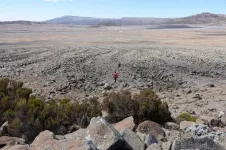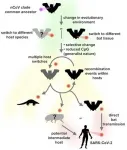(Press-News.org) A study of the relationship between temperature and yields of various rice varieties, based on 50 years of weather and rice-yield data from farms in the Philippines, suggests that warming temperatures negatively affect rice yields.
Recent varieties of rice, bred for environmental stresses like heat, showed better yields than both traditional rice varieties and modern varieties of rice that were not specifically bred to withstand warmer temperatures. But the study found that warming adversely affected crop yields even for those varieties best suited to the heat. Overall, the advantage of varieties bred to withstand increased heat was too small to be statistically significant.
One of the top 10 countries globally in rice production, the Philippines is also a top-10 rice importer, as domestic supply cannot meet demand.
Roderick Rejesus, a professor and extension specialist of agricultural and resource economics at North Carolina State University and the corresponding author of a paper that describes the study, says that teasing out the effects of temperature on rice yields is important to understand whether rice-breeding efforts have helped address the environmental challenges faced by modern society, such as global warming.
The study examined rice yields and atmospheric conditions from 1966 to 2016 in Central Luzon, the major rice-growing region of the Philippines. Rejesus and study colleagues were able to utilize farm-level data of rice yields and area weather conditions in four-to-five-year increments over the 50-year period, a rare data trove that allowed the researchers to painstakingly examine the relationship between rice yield and temperature in actual farm environments.
"This rich data set allowed us to see what was actually happening at the farm level, rather than only observing behavior at higher levels of aggregation like in provinces or districts," Rejesus said.
The study examined three general rice varieties planted during those 50 years: traditional rice varieties; "early modern varieties" planted after the onset of the Green Revolution, which were bred for higher yields; and "recent modern varieties" bred for particular characteristics, like heat or pest resistance, for example.
Perhaps as expected, the study showed that, in the presence of warming, recent modern varieties had the best yields when compared with the early modern and traditional varieties, and that early modern varieties outperformed traditional varieties. Interestingly, some of the early modern varieties may have also mitigated heat challenges given their smaller "semi-dwarf" plant architecture, even though they were not bred to specifically resist heat.
"Taken all together, there are two main implications here," Rejesus said. "The first is that, at the farm level, there appears to be a 'yield gap' between how rice performs in breeding trials and on farms, with farm performance of recent varieties bred to be more tolerant to environmental stresses not being statistically different relative to the older varieties.
"The second is that rice breeding efforts may not have reached their full potential such that it may be possible to produce new varieties that will statistically perform better than older varieties in a farm setting."
Rejesus also acknowledged that the study's modest sample size may have contributed to the inability to find statistical significance in the differences in warming impacts between rice varietal yields.
"This paper has implications for other rice-breeding countries, like Vietnam, because the timing of the release of various rice varieties is somewhat similar to that of the Philippines," Rejesus said. "Plant-breeding institutions can learn from this type of analysis, too. It provides guidance as to where research funding may be allocated by policymakers to further improve the high temperature tolerance of rice varieties available to farmers."
Rejesus plans to further study other agricultural practices and innovations that affect crop yields, including an examination of cover crops, or plants grown on cropland in the off season that aim to keep soils healthy, to gauge whether they can mitigate the adverse impacts of a changing climate.
INFORMATION:
The paper appears in the American Journal of Agricultural Economics. Former NC State Ph.D. student Ruixue Wang is the paper's first author. Jesse B. Tack from Kansas State University, Joseph V. Balagtas of Purdue University and Andy D. Nelson of the University of Twente are other paper co-authors. Support for the work was provided in part by the U.S. Department of Agriculture's NIFA Hatch Project No. NC02696.
- kulikowski -
Note to editors: An abstract of the paper follows.
Quantifying the Yield Sensitivity of Modern Rice Varieties to Warming Temperatures: Evidence from the Philippines
Authors: Ruixue Wang and Roderick Rejesus, North Carolina State University; Jesse B. Tack, Kansas State University; Joseph V. Balagtas, Purdue University; and Andy D. Nelson, University of Twente
Published: March 4, 2021 in American Journal of Agricultural Economics
DOI: 10.1111/ajae.12210
Abstract: This study examines the relationship between yields of modern rice varieties and warming temperatures. Data from a long-running farm-level survey in the Philippines, with rich information on planted rice varieties, allow us to estimate fixed effect econometric models of rice yields. We find that increases in temperature, especially minimum temperatures, have statistically significant negative impacts on rice yields. Point estimates of the marginal effect of higher temperatures on rice yields indicate that early modern varieties bred primarily for higher yields, pest resistance, and/or grain quality traits (i.e., not necessarily abiotic stress tolerance) tend to be more resilient to heat events than traditional rice varieties. Moreover, the marginal effect point estimates also suggest that more recent rice varieties bred for better tolerance to abiotic stresses are likely more resilient to warming than both traditional varieties and early modern varieties. Notwithstanding the heat resilience pattern suggested by these point estimates, we are unable to find statistically significant differences in the marginal yield response to warming across these three rice varietal groups. These results provide suggestive evidence that rice breeding efforts have improved resilience to warming temperatures and point to several interesting future research directions.
Intake of a high-fat diet leads to an increased risk for obesity, type 2 diabetes, cardiovascular diseases and fatty liver. A study in mice from Karolinska Institutet in Sweden shows that it is possible to eliminate the deleterious effects of a high-fat diet by lowering the levels of apolipoprotein CIII (apoCIII), a key regulator of lipid metabolism. The study is published in the journal Science Advances.
Increased levels of the protein apoCIII are related to cardiovascular diseases, insulin resistance and type 2 diabetes. Researchers at the Rolf Luft Research ...
New research led by the University of Cambridge has found rare evidence - preserved in the chemistry of ancient rocks from Greenland - which tells of a time when Earth was almost entirely molten.
The study, published in the journal Science Advances, yields information on a important period in our planet's formation, when a deep sea of incandescent magma stretched across Earth's surface and extended hundreds of kilometres into its interior.
It is the gradual cooling and crystallisation of this 'magma ocean' that set the chemistry of Earth's interior - a defining stage in the assembly of our planet's structure and the formation of our early atmosphere.
Scientists know that catastrophic impacts during the formation of the Earth and Moon would have generated ...
As the driver of global atmospheric and ocean circulation, the tropics play a central role in understanding past and future climate change. Both global climate simulations and worldwide ocean temperature reconstructions indicate that the cooling in the tropics during the last cold period, which began about 115,000 years ago, was much weaker than in the temperate zone and the polar regions. The extent to which this general statement also applies to the tropical high mountains of Eastern Africa and elsewhere is, however, doubted on the basis of palaeoclimatic, geological and ecological studies at high elevations.
A research team led by Alexander Groos, Heinz Veit (both from the Institute of Geography) and Naki Akçar (Institute of Geological Sciences) at the University ...
How much did SARS-CoV-2 need to change in order to adapt to its new human host? In a research article published in the open access journal PLOS Biology Oscar MacLean, Spyros Lytras at the University of Glasgow, and colleagues, show that since December 2019 and for the first 11 months of the SARS-CoV-2 pandemic there has been very little 'important' genetic change observed in the hundreds of thousands of sequenced virus genomes.
The study is a collaboration between researchers in the UK, US and Belgium. The lead authors Prof David L Robertson (at the MRC-University of Glasgow Centre for Virus Research, Scotland) ...
Informing how COVID-19 response plans may incorporate digital contact tracing, a model of COVID-19 spread within a simulated French population found that if about 20% of the population adopted a contact tracing app on their smartphones, an outbreak could be reduced by about 35%. If more than 30% of the population adopted the app, the epidemic could be suppressed to manageable levels. Jesús Moreno López and colleagues note that the effectiveness of digital contact tracing would depend on a given population's level of immunity to the virus; the intervention alone would be unable to suppress a COVID-19 epidemic where transmission - and especially asymptomatic transmission - remains high. While many countries have implemented ...
DURHAM, N.C. -- If you binged on high-calorie snacks and then spent the winter crashed on the couch in a months-long food coma, you'd likely wake up worse for wear. Unless you happen to be a fat-tailed dwarf lemur.
This squirrel-sized primate lives in the forests of Madagascar, where it spends up to seven months each year mostly motionless and chilling, using the minimum energy necessary to withstand the winter. While zonked, it lives off of fat stored in its tail.
Animals that hibernate in the wild rarely do so in zoos and sanctuaries, with their climate controls and ...
Decades of feminist gains in the workforce have been undermined by the COVID-19 pandemic, which has upended public education across the United States, a critical infrastructure of care that parents -- especially mothers -- depend on to work, according to new research from Washington University in St. Louis.
The research, published in Gender & Society, draws on new data from the Elementary School Operating Status (ESOS) database to show that the gender gap between mothers and fathers in the labor force has grown significantly since the onset of the pandemic in states where schools primarily offered remote instruction.
And if these circumstances continue, it could deliver ...
Sound sleep plays a critical role in healing traumatic brain injury, a new study of military veterans suggests.
The study, published in the Journal of Neurotrauma, used a new technique involving magnetic resonance imaging developed at Oregon Health & Science University. Researchers used MRI to evaluate the enlargement of perivascular spaces that surround blood vessels in the brain. Enlargement of these spaces occurs in aging and is associated with the development of dementia.
Among veterans in the study, those who slept poorly had more evidence of these enlarged spaces and more post-concussive symptoms.
"This has huge implications for the armed forces as well as civilians," said lead author Juan Piantino, M.D., MCR, assistant professor of pediatrics (neurology) in the ...
Astronomers have painted their best picture yet of an RV Tauri variable, a rare type of stellar binary where two stars - one approaching the end of its life - orbit within a sprawling disk of dust. Their 130-year dataset spans the widest range of light yet collected for one of these systems, from radio to X-rays.
"There are only about 300 known RV Tauri variables in the Milky Way galaxy," said Laura Vega, a recent doctoral recipient at Vanderbilt University in Nashville, Tennessee. "We focused our study on the second brightest, named U Monocerotis, which is now the first of these systems from which X-rays have been detected."
A paper describing the findings, led by Vega, was published in The Astrophysical Journal.
The system, called U ...
Water is perhaps Earth's most critical natural resource. Given increasing demand and increasingly stretched water resources, scientists are pursuing more innovative ways to use and reuse existing water, as well as to design new materials to improve water purification methods. Synthetically created semi-permeable polymer membranes used for contaminant solute removal can provide a level of advanced treatment and improve the energy efficiency of treating water; however, existing knowledge gaps are limiting transformative advances in membrane technology. One basic problem is ...




